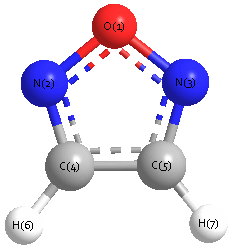Vibrational Frequencies calculated at TPSSh/6-31+G**
| Mode Number |
Symmetry |
Frequency
(cm-1) |
Scaled Frequency
(cm-1) |
IR Intensities
(km mol-1) |
Raman Act
(Å4/u) |
Dep P |
Dep U |
|---|
| 1 |
A1 |
3296 |
3172 |
0.39 |
111.26 |
0.11 |
0.19 |
| 2 |
A1 |
1460 |
1405 |
14.11 |
18.89 |
0.34 |
0.50 |
| 3 |
A1 |
1342 |
1291 |
2.58 |
22.81 |
0.04 |
0.08 |
| 4 |
A1 |
1069 |
1028 |
1.22 |
4.72 |
0.23 |
0.38 |
| 5 |
A1 |
1026 |
988 |
19.26 |
8.31 |
0.16 |
0.27 |
| 6 |
A1 |
893 |
860 |
22.40 |
6.12 |
0.12 |
0.21 |
| 7 |
A2 |
896 |
862 |
0.00 |
0.28 |
0.75 |
0.86 |
| 8 |
A2 |
646 |
622 |
0.00 |
0.18 |
0.75 |
0.86 |
| 9 |
B1 |
858 |
826 |
46.16 |
0.00 |
0.75 |
0.86 |
| 10 |
B1 |
641 |
617 |
1.09 |
0.43 |
0.75 |
0.86 |
| 11 |
B2 |
3281 |
3158 |
0.06 |
66.97 |
0.75 |
0.86 |
| 12 |
B2 |
1578 |
1518 |
0.00 |
0.08 |
0.75 |
0.86 |
| 13 |
B2 |
1202 |
1157 |
5.03 |
0.70 |
0.75 |
0.86 |
| 14 |
B2 |
957 |
921 |
17.34 |
3.77 |
0.75 |
0.86 |
| 15 |
B2 |
852 |
820 |
5.32 |
0.30 |
0.75 |
0.86 |
Unscaled Zero Point Vibrational Energy (zpe) 9997.6 cm
-1
Scaled (by 0.9625) Zero Point Vibrational Energy (zpe) 9622.7 cm
-1
See section
III.C.1 List or set vibrational scaling factors
to change the scale factors used here.
See section
III.C.2
Calculate a vibrational scaling factor for a given set of molecules
to determine the least squares best scaling factor.
Charges, Dipole, Quadrupole and Polarizability
Charges from optimized geometry at TPSSh/6-31+G**
Charges (e)
| Number |
Element |
Mulliken |
CHELPG |
AIM |
ESP |
| 1 |
O |
0.195 |
|
|
|
| 2 |
N |
-0.185 |
|
|
|
| 3 |
N |
-0.185 |
|
|
|
| 4 |
C |
-0.105 |
|
|
|
| 5 |
C |
-0.105 |
|
|
|
| 6 |
H |
0.193 |
|
|
|
| 7 |
H |
0.193 |
|
|
|
Electric dipole moments
Electric dipole components in Debye
(What's a Debye? See section
VII.A.3)
| |
x |
y |
z |
Total |
| |
0.000 |
0.000 |
-3.495 |
3.495 |
| CHELPG |
|
|
|
|
| AIM |
|
|
|
|
| ESP |
|
|
|
|
Electric Quadrupole moment
Quadrupole components in D Å
Polarizabilities
Components of the polarizability tensor.
Units are
Å
3 (Angstrom cubed)
Change units.
| |
x |
y |
z |
| x |
3.528 |
0.000 |
0.000 |
| y |
0.000 |
6.609 |
0.000 |
| z |
0.000 |
0.000 |
6.440 |
<r2> (average value of r
2) Å
2
| <r2> |
72.876 |
| (<r2>)1/2 |
8.537 |
